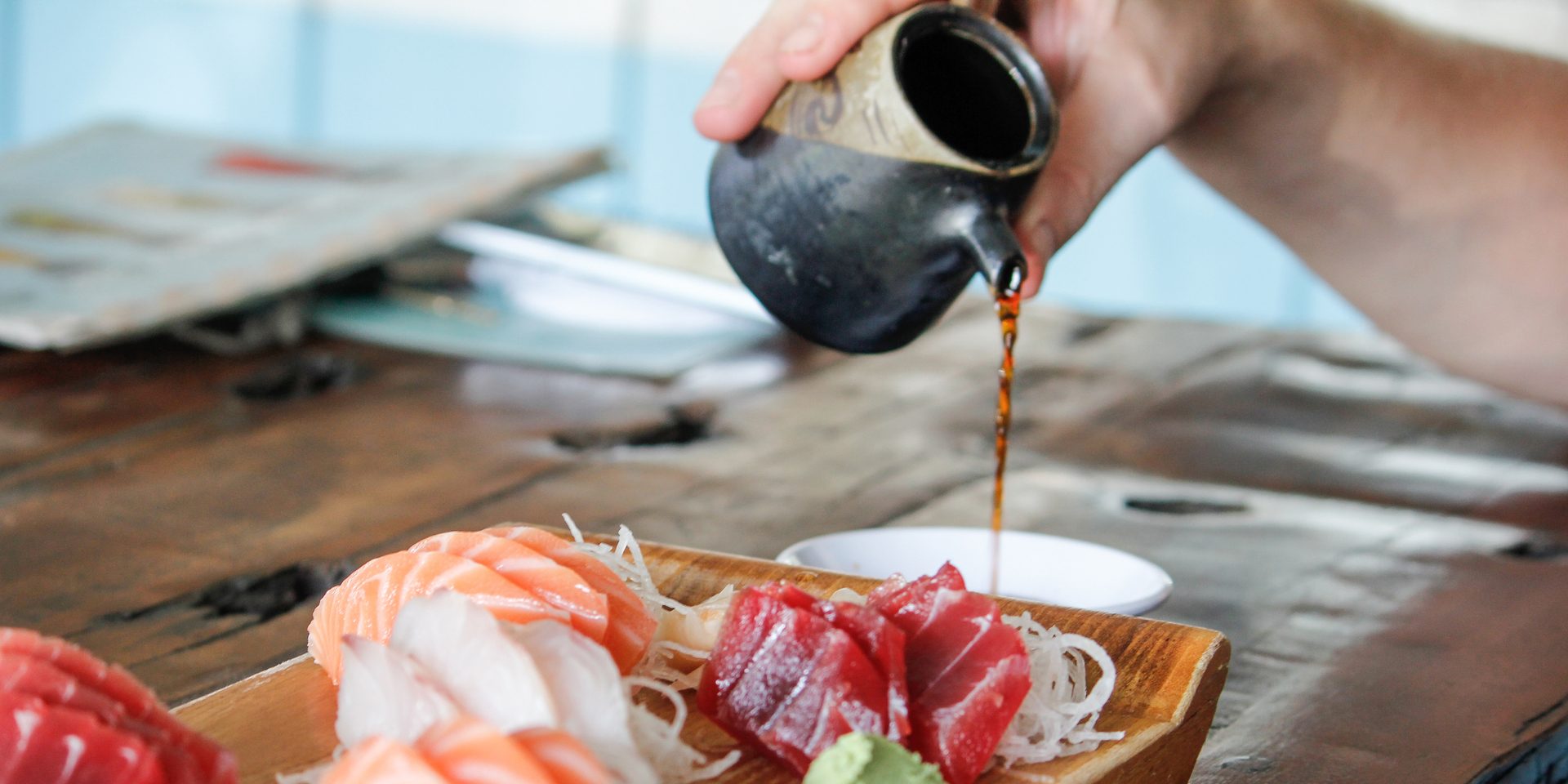
Hold the sauce: new report finds swapping your sauce can half your salt intake
A couple of sushi rolls or a veggie stir-fry can be healthy lunch options but if you’re dousing them with a salty soy sauce you could be putting your health at risk. A new report from The George Institute for Global Health, VicHealth and the Heart Foundation has found a single tablespoon of the average soy sauce contains 61 percent of our recommended daily salt intake. Alternatively, if you use just one small soy sauce plastic fish packet on a sushi roll, you’ll be eating nearly ten percent of your daily salt intake.
The report is part of the Unpack the Salt campaign and analysed the salt content in more than 150 of our favourite Asian style sauces from Australia’s four major supermarkets from 2010 to 2018.
While the report found fish sauce to be the saltiest – one tablespoon of the popular Asian ingredient containing a whopping 96 percent of the recommended daily salt intake on average – it was the variation in salt levels of different soy sauces that caught the attention of health experts.
Heart Foundation Dietitian Sian Armstrong said the fact that some soy sauces contained more than double the amount of salt than others showed manufacturers can make their products less salty.
“We know that stir-fry dishes are really popular because they are quick, fresh and healthy but too many of us are unaware of just how much salt is hidden in the sauces we use,” Ms Armstrong said.
“A tablespoon of the saltiest soy sauce contains nearly 90 percent of your recommended daily salt intake, whereas the lowest salt soy sauce had less than half of that.
“Too much salt can cause high blood pressure, which increases your risk of stroke, heart and kidney disease. One of the best ways to keep your blood pressure down is by eating less salt so choose a reduced salt soy sauce when you’re cooking a stir-fry and go easy on the sauce.”
Key findings:
- On average, one tablespoon of soy sauce contains 61% of your recommended maximum daily salt intake
- One soy sauce fish packet can contain nearly 10% of your entire days recommended maximum daily salt intake
- The saltiest soy sauce, Chang's Light Soy Sauce (21.9g of salt per 100ml) had more than double the amount of salt as the lowest salt soy sauce, Kikkoman Naturally Brewed Less Salt Soy Sauce (9.5g of salt per 100ml)
- Fish sauce is the saltiest Asian style sauce. On average one tablespoon has 96% of the max daily salt intake
- Oyster sauce has the lowest salt per tablespoon, although on average still 36% of recommended daily salt intake
See asian style sauces with highest and lowest sodium content (PDF 470 KB)
The George Institute’s Public Health Nutritionist and the report’s lead author Clare Farrand said it was a real concern that in almost a decade there had been no reduction in the salt levels in these popular sauces.
“The average soy sauce contains 61 percent of your maximum daily salt intake and for fish sauce it’s even higher with 96 percent of your recommended daily salt intake in one tablespoon,” Ms Farrand said. “In the past decade we’ve seen no reduction in the amount of salt in these sauces and there are no targets in place to bring about change.
“People assume soy sauces can’t be made less salty, but this report shows that’s not the case, with some soy, tamari and oyster sauces containing much lower salt levels. We want to see all manufacturers reducing the salt levels in their sauces – it can be done.”
VicHealth CEO Jerril Rechter said soy sauce aficionados didn’t have to give up the saucy elixir altogether – just swap to a reduced salt option.
“The great news is this report shows you can easily find reduced salt soy sauces at your local supermarket and most people can’t taste the difference between the lower and higher salt versions,” Ms Rechter said.
“Look for sauces with a reduced salt label, check the nutrition panel at the back or scan the sauce with the FoodSwitch app when you’re doing your shopping to find the best option for you and your family.
“Tamari and oyster sauces tend to have less salt so try them next time you fire up your wok and make sure to include lots of fresh veggies for a healthy and colourful dish.”
Sign up and Join the Unpack your Lunch 10-day Salt Challenge
Take the first step towards reducing salt in your lunch. Sign up today at Unpack your Lunch 10-day Salt Challenge. You can also find great stir-fry recipes.
The website was launched by VicHealth and the Heart Foundation to raise awareness about the high levels of salt in processed and packaged foods and provide practical tips to reduce salt intake.
Tips for consumers:
- Be aware of portion size and try to use salty sauces sparingly
- Use natural, no-salt flavourings such as lemon, herbs and spices, including fresh garlic, chilli, ginger and vinegar when preparing Asian style meals
- The best way to reduce salt is to eat more fresh foods and reduce your reliance on processed and packaged foods including pre-made sauces
- Sodium is one component of salt – it is the sodium that is labelled on nutrition information panels on packaged foods
- Choose ‘reduced salt’ products and check the label to choose the lower sodium option
- Download the FoodSwitch app to scan product barcodes to find an alternative product with a lower sodium content. Available to download from www.foodswitch.com.au
- Use the Australian Guide to Healthy Eating as a guide to make healthier choices
About the Victorian Salt Reduction Partnership
The Victorian Salt Reduction Partnership was established in 2014 in response to alarming high levels of salt consumption by the Victorian public. The partnership comprises of peak public health organisations: VicHealth, Heart Foundation (Victoria), The George Institute for Global Health, Deakin University Institute for Physical Activity and Nutrition (IPAN), National Stroke Foundation, Kidney Health Australia, The Victorian Department for Health and Human Services, Baker Heart and Diabetes Institute and the High Blood Pressure Research Council. Australia is committed to meeting the World Health Organization’s target of 30 percent reduction in average population salt intake by 2025. To achieve this, the partnership has developed a comprehensive set of actions aimed at gaining consensus and commitment for salt reduction action from governments, public and industry in Victoria.



